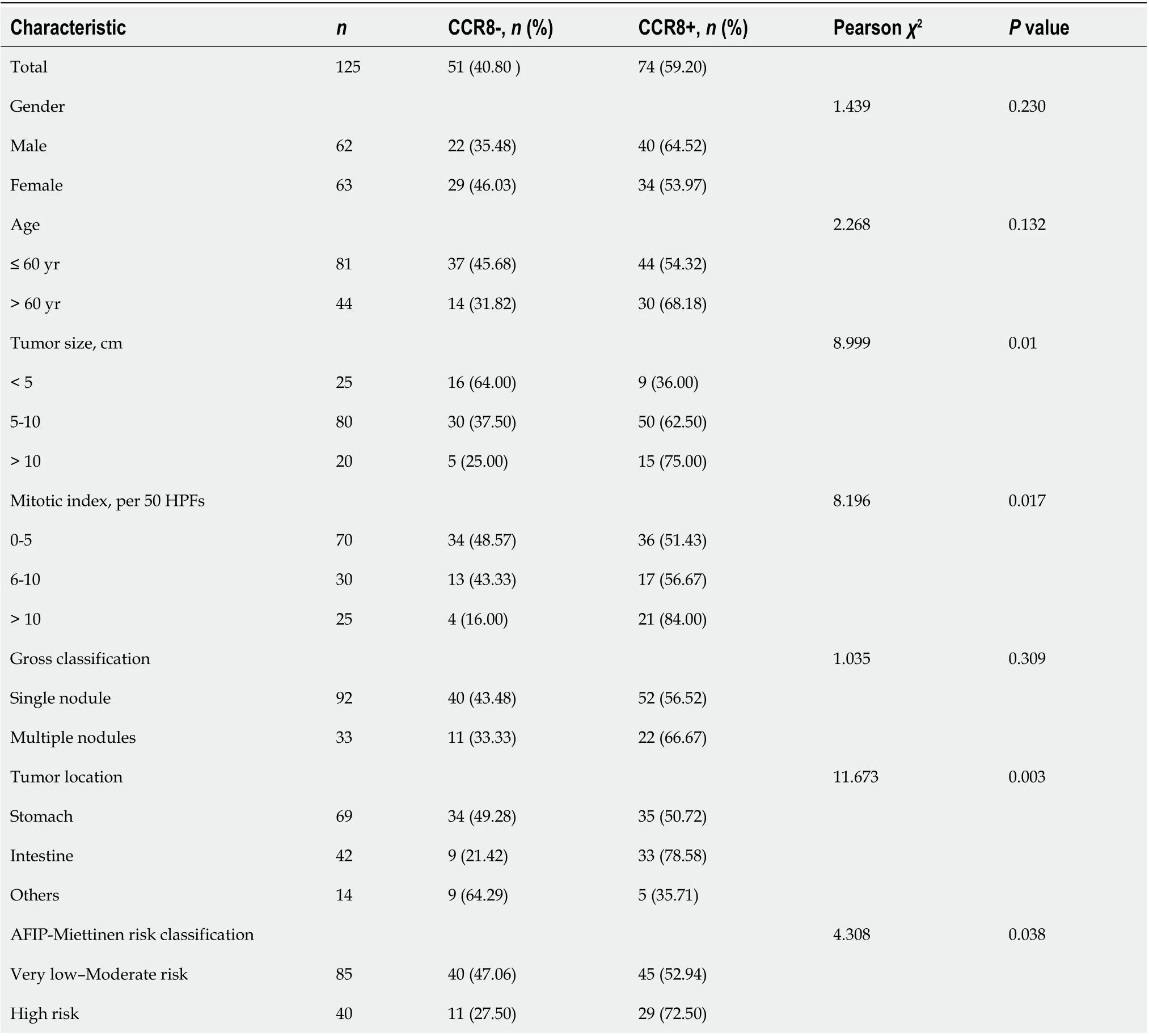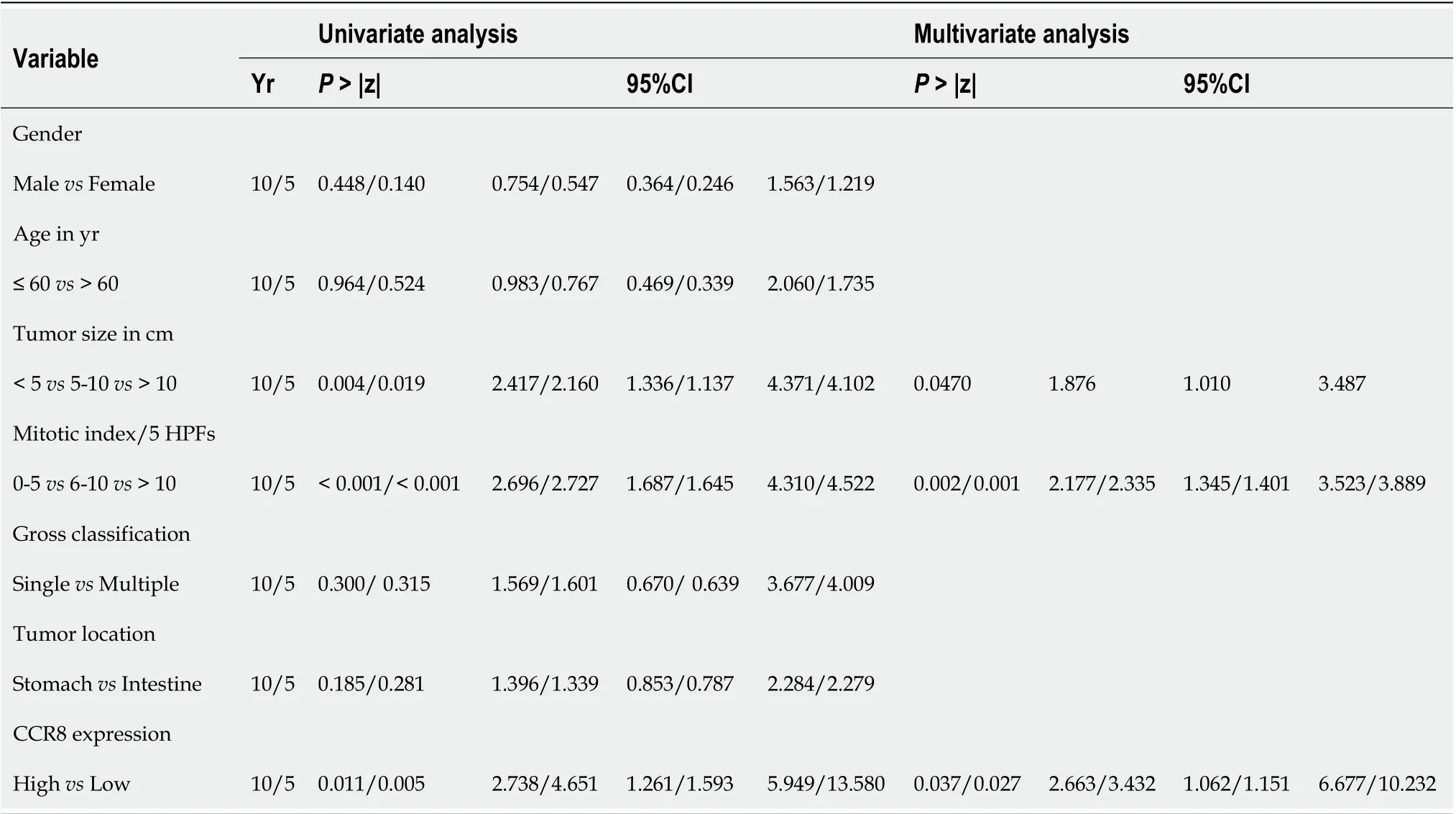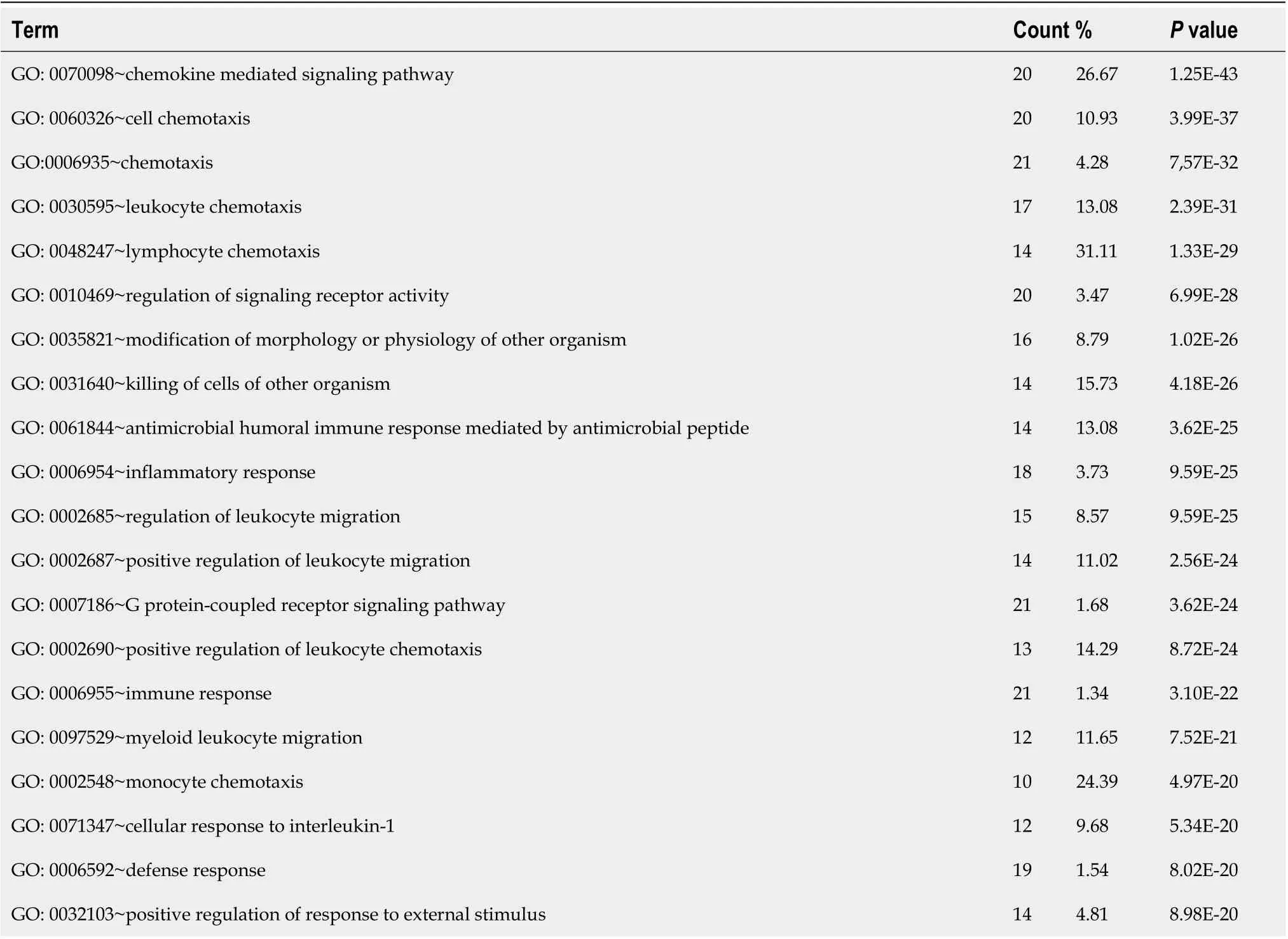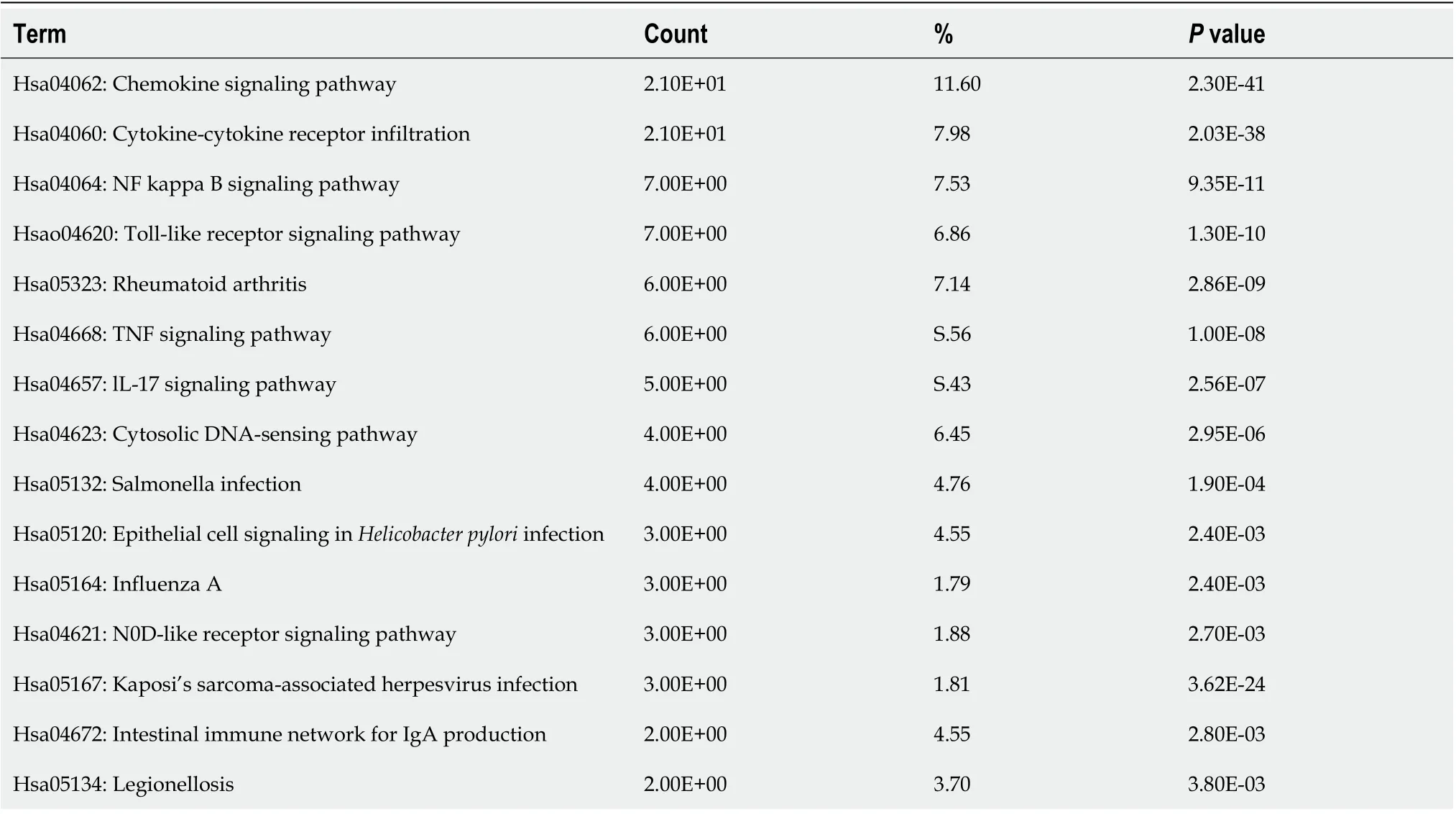Clinical and prognostic significance of CC chemokine receptor type 8 protein expression in gastrointestinal stromal tumors
2020-09-23HuaiLiangLiLinHuaWangYiLinHuYingFengXiaoHongLiYiFeiLiuPengLiQinShengMaoWanJiangXue
Huai-Liang Li, Lin-Hua Wang, Yi-Lin Hu, Ying Feng, Xiao-Hong Li, Yi-Fei Liu, Peng Li, Qin-Sheng Mao, Wan-Jiang Xue
Abstract
Key words: Gastrointestinal stromal tumors; CC chemokine receptor type 8; Malignant phenotype; Prognosis; STRING database; Immune regulation
INTRODUCTION
Gastrointestinal stromal tumors (GISTs) are invasive tumors with malignant potential derived from the gastrointestinal mesenchymal tissue and account for 1%-3% of gastrointestinal malignant tumors[1]. Surgical resection remains the main treatment for GISTs. Unfortunately, more than 50% of patients eventually develop local recurrence or metastasis[2]. Although imatinib is the standard first-line therapy for patients with metastatic or advanced GISTs and can improve their median progression-free survival and median overall survival[3-6], it cannot cure the disease. The prognosis of the advanced cases is not optimistic.
Investigators have shown that the immune system was suppressed in the microenvironment of GISTs[7]. Chemokine receptors and their ligands played crucial roles in tumor immune responses. In the tumor microenvironment, chemokine receptors are beneficial for the recruitment of tumor immune cells, such as bone marrow-derived suppressor cells, tumor-associated macrophages and regulatory T cells (Tregs), which are associated with poor prognosis in various solid malignancies[8-11]. Recent studies suggested that the organ-selective patterns of tumor metastases were determined by the chemokine receptor/ligand axis[12,13].
CC chemokine receptor type 8 (CCR8) is one of the most important chemokine receptors and is mainly expressed in Tregs with small proportions of expression in T helper 2 cells and monocytes[14-17]. CCR8 has four known ligands: CCL1, CCL8, CCL16 and CCL18[18]. Inngjerdingenet al[19]confirmed that CCL1/CCR8 is the key axis for tumor immunity. Specifically, CCL1 enhances Treg immunosuppressive activity by recruiting CCR8, FOXp3 and IL-10 with a positive feedback mechanism. Recently, CCR8 was reported to be correlated with poor prognosis in non-small cell lung cancer and colorectal cancer[20]. However, the expression of CCR8 in GISTs, its relationship with clinical features and its impact on prognosis remain unclear.
In this study, we examined CCR8 expression in GISTs by immunohistochemistry and analyzed its clinical and prognostic importance. Using the STRING database, we mapped a Gene Ontology (GO)/Kyoto Encyclopedia of Genes and Genomes (KEGG) single-gene enrichment chart for CCR8. The present results may offer a basis for prognosis assessment and identify a new therapeutic target for GISTs.
MATERIALS AND METHODS
Patients
The study included 125 patients with GISTs at the Department of Pathology of the Affiliated Hospital of Nantong University and Third Affiliated Hospital of Nanjing Medical University from 2002 to 2012 with relatively complete clinicopathological and follow-up data. The diagnostic criteria for GISTs were consistent with histopathological features and positive for CD117 immunohistochemistry, negative for CD117 but positive for DOG1 or negative for both, while immunohistochemistry for desmin, S-100 and smooth muscle actin were negative (to exclude neurogenic and smooth muscle tumors)[21]. The basic clinical data included tumor size, sex, age, mitotic index, total classification, tumor grade and tumor location. The AFIP-Miettinen risk classification was used to assess the potential risk of malignancy. All patients included in this study were treated with surgical resection, without preoperative radiotherapy or chemotherapy. Cases with distant metastasis were not enrolled in the research. In addition, patients were not treated with postoperative tyrosine kinase inhibitors, such as imatinib.
Tissue microarray
The tissue microarray was manufactured by Shanghai Outdo Biotech Co. Ltd. (Shanghai, China). Based on the results of hematoxylin and eosin staining, representative GIST regions were marked on specific paraffin blocks. The above 125 formalin-fixed and paraffin-embedded GIST tissues were collected, and 2 mm diameter samples were acquired by inserting tissue array needles. The obtained samples were aligned on blank paraffin blocks and cut into 4 µm sections.
Immunohistochemical staining
The sections (4 µm) were conventionally dewaxed and rehydrated. The tissue microarray was incubated for 1 h with an anti-CCR8 primary antibody (1:200; Abcam, Cambridge, United Kingdom) in tris-buffered saline, washed and incubated with a horseradish peroxidase-conjugated anti-goat secondary antibody (1:2000; Santa Cruz Biotechnology, Santa Cruz, CA, United States). Immunostaining of CCR8 was scored by two pathologists based on the intensity and density of the CCR8-positive signals. Staining intensity was scored according to four grades: 0, 1, 2 or 3, ranging from negative and weak to strong intensity. Positive staining intensity: 0 for colorless, 1 for light yellow, 2 for brown and 3 for tan. The density of CCR8-positive cells was also scored at four levels: 0 for 0-25%, 1 for 26%-50%, 2 for 51%-75% and 3 for 76%-100%[21]. The product of the intensity and density scores was used as the CCR8 staining score. The degree of CCR8 staining was quantified using a two-level grading system, and staining scores were defined as follows: 0 or 1: Low expression; and 2-9: High expression.
Statistical analysis
The correlations between CCR8 and clinicopathological features were analyzed by the chi-square test. Survival rates were assessed by Kaplan–Meier analysis, and Cox regression was utilized to confirm the factors affecting the prognosis of GISTs. All statistical analyses were performed with SPSS version 18.0 software (SPSS, Chicago, IL, United States). Values ofP< 0.05 were considered statistically significant.
Bioinformatics
Single-gene GO/KEGG enrichment was conducted with STRING Version 11.0 software (https://string-db.org), the settings include basic settings and advanced settings. The basic settings section mainly has several parts: Meaning of network edges: Evidence; active interaction sources: Text-mining; experiments; databases; coexpression; neighborhood; gene fusion; cooccurrence; minimum required interaction score: High confidence (0.700); maxnof interactors to show: No more than 20 interactors. Advanced settings include two parts: Network display mode: Interactive svg; and display simplifications: Hide disconnected nodes in the network.
RESULTS
Clinical features of the patients with GISTs
The study included a total of 125 patients comprised of 62 men and 63 women. It included 81 patients aged ≤ 60 years and 44 aged > 60 years. For tumor sizes, 25 had tumor diameters < 5 cm, 80 had tumor diameters 5-10 cm, and 20 had tumor diameters > 10 cm. Furthermore, 92 patients had single nodules, and 33 had multiple nodules. For tumor locations, 69 were located in the stomach, 42 in the intestine and 14 in other organs. Regarding the mitotic index, 70 patients were 0-5, 30 were 5-10, and 25 were > 10. According to the AFIP-Miettinen risk classification assessment, 85 patients were low to moderate risk, and 40 were high risk.
CC chemokine receptor type 8 expression and localization in gastrointestinal stromal tumors tissues by immunohistochemistry
Immunohistochemical analysis showed that CCR8-positive signals as brown-yellow or brown particles were localized in the cytoplasm of GIST tissues (Figure 1). In tumor cells, 74 (59.20%) of the 125 GIST tissues exhibited high CCR8 protein expression with cytoplasm staining, and the remaining 51 showed low or no staining of the CCR8 protein.
Relationships between CC chemokine receptor type 8 and clinicopathological features
We analyzed the correlations between CCR8 expression and clinicopathological features of the 125 patients with GISTs. The results indicated that CCR8 expression was associated with tumor size (P= 0.018), mitotic index (P= 0.017), AFIP-Miettinen risk classification (P= 0.038) and tumor location (P= 0.003) regardless of gender, age, gross classification and other features (Table 1).
Survival analysis
Kaplan–Meier survival curves showed that patients with low CCR8 expression (Figure 2A), mitotic index < 5/HPF (Figure 2B) and tumor diameter < 5 cm (Figure 2C) had a better prognosis. Multivariate analyses proved that CCR8 expression was significantly associated with poor prognosis, 5-year overall survival rate (P= 0.005) and 10-year overall survival rate (P= 0.011) in patients with GISTs (Table 2). As other important clinical factors, tumor size was significantly correlated with 10-year survival rate (univariate analysisP= 0.004, multivariate analysisP= 0.047). Mitotic index was correlated with poor prognosis, with 5-year overall survival rate (P< 0.001) and 10-year overall survival rate (univariate analysisP< 0.001, multivariate analysiskP= 0.002).
Gene Ontology/Kyoto Encyclopedia of Genes and Genomes single-gene enrichment analysis of CC chemokine receptor type 8 using the STRING database
According to the built-in KEGG/GO module in the STRING database for single-gene enrichment analysis, 143 significantly up-regulated GO pathways and 19 significantly up-regulated KEGG pathways were found (P< 0.05). We choose 15 GO pathways and 8 KEGG pathways for further examination and found that they were mainly related to immune processes, T lymphocyte chemotaxis and lymphocyte migration in the GO pathways (Table 3) and enriched in the tumor necrosis factor and nuclear factor (NF)-κB pathways and intestinal immune regulation networks for the KEGG pathways (Table 4).

Table 1 Correlations between clinicopathological features and CC chemokine receptor type 8 expression in gastrointestinal stromal tumors
DISCUSSION
GISTs are the most common digestive tract mesenchymal tumors with malignant potential. The National Comprehensive Cancer Network GIST guidelines describe that their malignant potential is associated with tumor size and mitotic index[22,23], both of which are considered in the National Institutes of Health risk classification of GISTs. Early studies showed that the malignant phenotype of GISTs was not only associated with these clinical pathological features but also related to molecular factors, such as long noncoding RNAs, microRNAs and other specific molecules that can accurately predict the risk of malignancy[24]. HOX antisense intergenic RNA was reported to be highly expressed in the high-risk group of GISTs and to facilitate proliferation, invasion and metastasis[25]. Besides, overexpression of miR-196a was reported to be associated with high-risk grade and poor survival in patients with GISTs.
分别称取两种大米淀粉各50 g,将水分含量调至20%(将淀粉与水充分混合后,在4 ℃低温条件下平衡水分 24 h)。然后将淀粉置于湿热处理系统中,在100 ℃条件下反应2 h。反应结束后取出产物,在45 ℃烘箱干燥12 h后粉碎,过160目筛,即获得湿热处理后的大米样品,分别命名为YF20、YJ20。
In the present study, we first discovered that CCR8 was expressed in the cytoplasm, and the immunohistochemistry was brown or brown-yellow particles. The positive expression rates of CCR8 in the GIST tissues with tumor diameter < 5 cm, 5-10 cm and > 10 cm were 36.00%, 62.50% and 75.00% (P< 0.05), respectively. The positive rates of CCR8 in the GIST tissues with mitotic index 0-5/HPFs, 6-10/HPF and > 10/HPFs, were 51.43%, 56.67% and 84.00%, respectively (P< 0.05), indicating that the expression of CCR8 may be related to the uncontrolled increase of GIST. In addition, theexpression of CCR8 is associated with tumor localization. In the stomach and small intestine, the positive expression rates of CCR8 were 50.72% and 79.07%, respectively (P< 0.05). Miettinenet al[25]found that the malignant potential of small intestinal stromal tumors was higher than that of gastric stromal tumors, which may be associated with higher exon 9 mutation rate in small intestinal stromal tumors, regardless of CCR8 expression. The prognosis of GIST patients in two sites was not statistically significant. In this study, high expression of CCR8 was correlated with tumor size and mitotic index and may be a biomarker for prediction of the malignant potential of GISTs.

Table 2 Univariate and multivariate analysis of factors affecting prognosis in GISTs
The STRING database was used to map a GO single-gene enrichment chart of CCR8, which was enriched in biological processes, such as immune response, T lymphocyte chemotaxis and lymphocyte migration. Recent studies showed that the CCR4/CCL22 axis recruited Tregs to the tumor site, leading to tumor immune tolerance and was negatively correlated with tumor prognosis[26-29]. CCR8 recruited FOXp3+ Treg cells to exert an immunosuppressive function, ultimately resulting in a decreased proportion of CD8+ T cells/Tregs and leading to a poor prognosis of solid tumors[30-33]. Karin[22]even proposed the idea that chemokines and their receptors can act as immunological checkpoints for tumor therapy, pointing out that CCR8+ FOXp3+ regulatory T cells are the main driving factors of immune regulation and provided the possibility of using CCR8 as a therapeutic target.
Very recently, monoclonal antibodies targeting CCR8 were shown to significantly inhibit tumor growth and improve long-term survival in a colorectal cancer mouse model, which associated with increased infiltration of CD4+ CD8+ T cells and a significant decrease in the frequency of tumor-resident CD4+ CCR8+ Tregs. This resulted in an increased proportion of CD8+ T cells/Tregs[34]. Thus, blockage of CCR8 expression may improve the prognosis of patients with these tumors. In this study, survival curves suggested that patients with GISTs showing high CCR8 expression had a poor prognosis. Thus, we inferred that expression of CCR8 was correlated with progression of GISTs and may even be a potential therapeutic target for GISTs.
A KEGG single-gene enrichment chart of CCR8 was obtained using the STRING database and was enriched in the tumor necrosis factor and NF-κB pathways and intestinal immune regulation networks. Interestingly, upregulation of Notch1 by CCR7 promoted the invasion and metastasis of prostate cancer cells by activating the MAPK and NF-κB signaling pathways in prostate cancer[35]. In colorectal cancer, CCR4 in the downstream of the tumor necrosis factor-α pathway promoted metastasisviathe ERK/NF-κB/MMP13 pathway[36]. Besides, CCR6 was reported to facilitate tumorangiogenesis by the NF-κB/VEGF pathway in colorectal cancer[37]. Moreover, the CCL20/CCR6 axis was proven to promote the invasion and migration of thyroid cancer cells through MMP3 induced by NF-κB signaling[38]. Estrogen promoted progression of hormone-dependent breast cancer through the CCL2/CCR2 axis by upregulating TwistviaPI3K/AKT/NF-κB signaling[39]. CCR5 upregulated the expression of transforming growth factor β1, which ultimately induced epithelialmesenchymal transition and migrationviaPI3K/AKT/GSK3β signaling in melanoma. Recently, CCL1 was shown to enhance migration, invasion and epithelialmesenchymal transition by binding to CCR8 in bladder cancer[40-44]. Therefore, we speculated that expression of CCR8 can affect the progression of GISTs through the above mechanisms.

Table 3 Gene Ontology (Biological Process) enrichment of CC chemokine receptor type 8
There are some limitations to this study. We lacked a large sample and multi-center study. Meanwhile, there are few advanced GIST cases. In addition, we also lacked relevant cytological studies. Our future studies will continue to solve those problems and examine the specific role of CCR8 in GIST immunization. In conclusion, high expression of CCR8 may be related to the malignant phenotype and negatively correlated with prognosis in GISTs. CCR8 can be used as an independent predictor of GIST prognosis and a potential therapeutic target.

Table 4 Kyoto Encyclopedia of Genes and Genomes enrichment of CC chemokine receptor type 8
ARTICLE HIGHLIGHTS
Research background
Gastrointestinal stromal tumors (GISTs) are the most common mesenchymal neoplasms of the gastrointestinal tract. Surgical resection remains the main treatment for GISTs. Unfortunately, more than 50% of patients eventually develop local recurrence or metastasis. Although imatinib is the standard first-line therapy for patients with metastatic or advanced GISTs, it cannot cure the disease. The prognosis of the advanced cases is not optimistic. CC chemokine receptor type 8 (CCR8) protein participates in regulation of immune responses. Recent studies on CCR8 in non-small cell lung cancer and colorectal cancer showed that it was highly expressed in tumorinfiltrating regulatory T cells and correlated with a poor prognosis. However, there are only a few references on the expression of CCR8 protein in gastrointestinal stromal tumors.
Research motivation
The following problems, which we need to solve urgently, are also the research motivation of this article: (1) The function of the CCR8 in tumor immunity; (2) The relationship between the CCR8 expression and GIST clinical data; and (3) The relationship between the prognosis of GIST and CCR8.
Research objectives
In this study, we examined the expression of CCR8 in GISTs by immunohistochemistry to explore the clinical significance of GIST expression and its prognosis. Based on the STRING database, we predicted the potential immunological function of CCR8. This research will provide evidence and support for the diagnosis of GIST, prognostic evaluation and new tumor treatment targets.
Research methods
Tissue samples were used for the tissue microarray construction. The microarrays were then subjected to immunohistochemical analyses to detect CCR8 expression. Next, Kaplan–Meier analysis was utilized to calculate the survival rate of patients with complete follow-up data, and the potential prognostic value of CCR8 was evaluated by Cox regression analysis. Finally, a Gene Ontology/Kyoto Encyclopedia of Genes and Genomes single-gene enrichment chart of CCR8 was constructed using the STRING database.
Research results
CCR8-positive signals were detected as brown or brown-yellow particles by immunohistochemistry located in the cytoplasm. Among 125 tissue samples, 74 had CCR8 high expression, and 51 had low or negative expression. Statistical analyses suggested CCR8 was significantly correlated with tumor size, mitotic index, AFIPMiettinen risk classification and tumor location. Kaplan–Meier and multivariate analyses showed that patients with low or negative CCR8 expression, mitotic index < 5/high-power field and tumor diameter < 5 cm had a better prognosis. Based on the STRING database, CCR8 was significantly enriched in biological processes such as tumor immunity, T lymphocyte chemotaxis, migration and pathways like the nuclear factor-κB and tumor necrosis factor pathways as well as intestinal immune regulation networks.
Research conclusions
The expression of CCR8 protein in GISTs correlated with tumor size, mitotic index, AFIP-Miettinen risk classification. Each index suggested that the higher the degree of malignancy was associated with higher CCR8 expression. When compared with other factors (age, sex, tumor location,etc), there was no relationship with CCR8. CCR8 low expression was positively correlated with the survival of patients with GISTs, which has some implications for the prognosis of patients. CCR8 can be used as an independent factor to evaluate the prognosis of GISTs. CCR8 was significantly enriched in biological processes such as tumor immunity, T lymphocyte chemotaxis, migration and pathways like the nuclear factor-κB and tumor necrosis factor pathways as well as intestinal immune regulation networks. These will provide ideas for future research about the specific mechanism of CCR8 in tumor immunity.
Research perspectives
Tumor immunity is currently a hotspot in cancer research, and the chemokine ligand/receptor axis plays an important role in the tumor immune mechanism of which CCR8 is the most brilliant one. Meanwhile, more and more studies focus on the immunopathogenesis of gastrointestinal stromal tumors. However, data on the relationship between CCR8 and the pathogenesis and treatment of GIST still remains unclear. This article is only a preliminary exploration of the study of CCR8 in gastrointestinal stromal tumors. The specific immunological mechanism of CCR8 in gastrointestinal stromal tumors is worthy of further exploration. We believe CCR8 could be a potential therapeutic target of GISTs.
猜你喜欢
杂志排行
World Journal of Gastroenterology的其它文章
- Current understanding of the metabolism of micronutrients in chronic alcoholic liver disease
- Establishment of a pattern recognition metabolomics model for the diagnosis of hepatocellular carcinoma
- Monocyte-to-lymphocyte ratio as a prognostic factor in peripheral whole blood samples of colorectal cancer patients
- Initial experience of single-incision plus one port left-side approach totally laparoscopic distal gastrectomy with uncut Roux-en-Y reconstruction
- Feasibility and efficacy evaluation of metallic biliary stents eluting gemcitabine and cisplatin for extrahepatic cholangiocarcinoma
- Impact of interval between neoadjuvant chemoradiotherapy and surgery in rectal cancer patients
